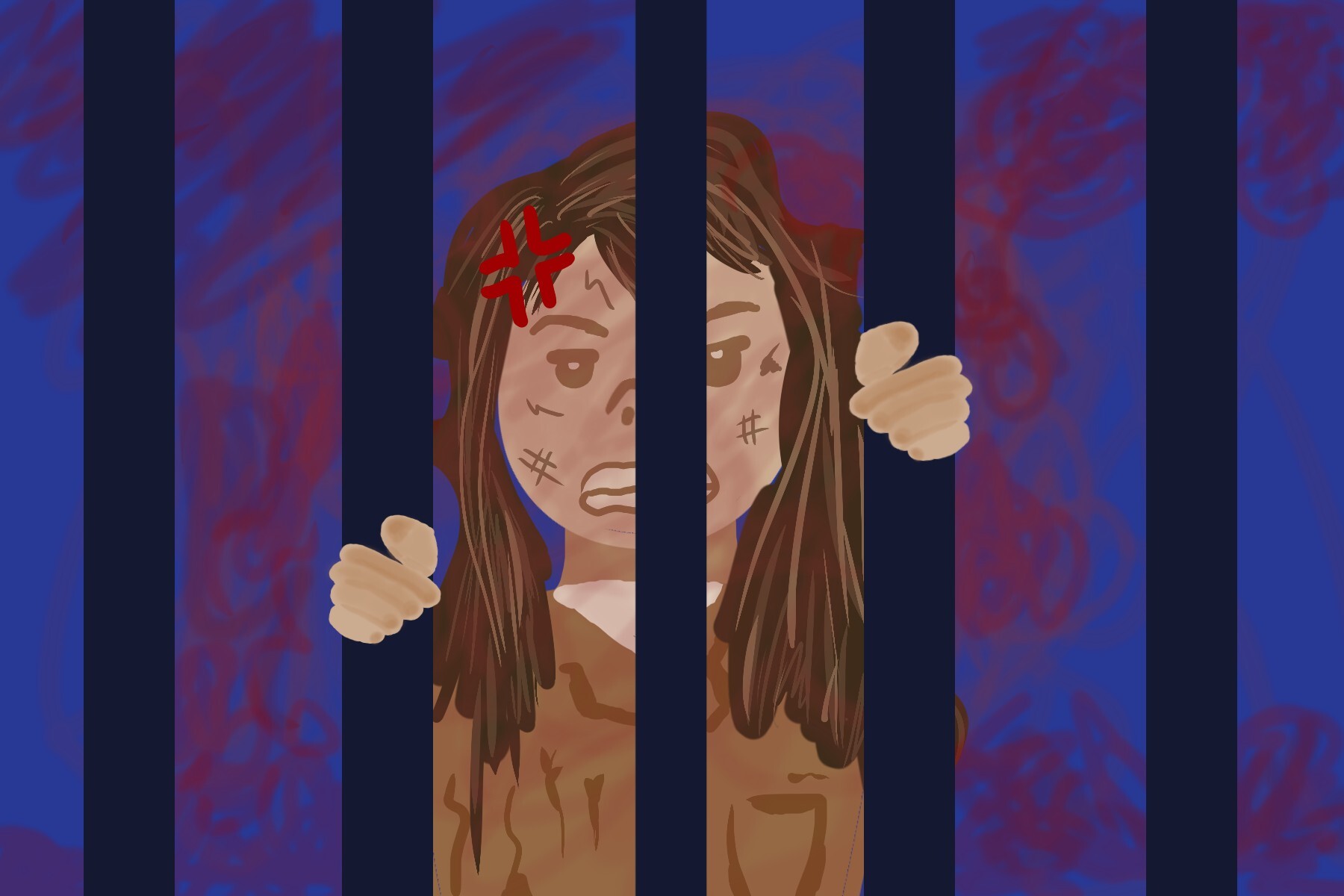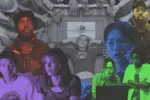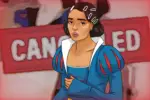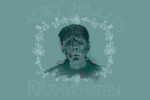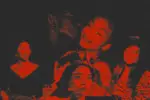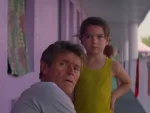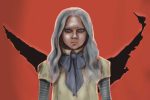Women have long dominated the genre of horror, in terms of being seen in relation to the harm, victimization and dehumanization they experience as a sex and the violence committed against them on screen — the graphic injuries sustained by the violated female sexes who appear often as props: well-manicured, machines, well-oiled, and broken parts, fragmented and disfigured, bodies and faces cracked open, jaw wide open in horror, mouth hanging, voraciously hungering, still deliberating, still processing the violence that has happened to them. The picturesque image of [male] domination — the dominant representation of horror that doesn’t reflect or capture the complexity of female experiences. So often, in these representations, horror happens to women.
Men insert their phalluses, their fingers, their objects into women — they sharpen their knives, lay down their axes and their chainsaws. Lay down a female victim, hog-tie her, wrap her wrists together in a silk scarf she’d worn before being cornered, ransacked, looted, pillaged and obliterated. Hammer her down onto a wooden table, carve her with a serrated kitchen knife, dice her into origami, fashion yourself a Picasso, a painter, an artist, turn her into a masterpiece, your creation — a traumatized dancer — the girl was a former ballerina, how fitting.
Use her shoelaces to paint the picture of her objectification. Zoom in. Use the camera lens to photograph her death as she is living — highlight the perversion of it all, the necessity of female desecration. Turn her, the holy object, your superstar, into an unholy object. Make the pretty woman obscenely ugly. Use your perverted art to make her beautiful again, your personal Mona Lisa.
Eviscerate her hopes. Make the unrecognizable face recognizable. Turn the tortured girl into a face she can recognize in the mirror, turn her into a bird, a magpie. Turn the magpie into a Mother Mary, a Madonna, and then turn her into a demon and you, the savior of her — she, the crucified object — into a demon-slayer. Photograph her degradation, her humiliation. Make sure audiences’ faces turn in revulsion. Turn the female slasher film into a blockbuster.
Women offer the quintessential picture of the grotesque, of blood and gore and filth, in horror scenes; they dominate horror tropes. Female horror, however, offers an invitation for women to be seen not only as horror victims or passive subjects, pretty girls to be looked at and digested, or objects to be consumed by the male gaze, but as powerful women, weapons, archetypes of female monstrosity: ugly women; feral women; decapitated women brought back to life as ghouls and ghosts from the dead, bodies that haunt; phantoms, apparitions and specters; satanic ritualists; sadistic castrators; succubi; cannibalizing countesses; women-killers; illegitimate women; vulgar women; unrespectable women; bastardized playthings and Barbie figurines turned life-size dolls; girls who commit matricide or femicide — monstrous Medusas and other fearful types of women — girls straight out of hell, if you will. Women who pilot their own lives.
Female horror asks, how can we determine monstrosity among women? How can we introduce the idea of moral ambivalence? How can we redefine women instead of further their emasculation? How can we disrobe them outside of the male sphere, including the male sphere of violence? How can we demythologize the female body in relation to sexuality, in relation to hunger, in relation to illness? How can we make the body a site of protest, a site of radical self-acceptance? How can we alter the experience of being human through the lens of monstrosity, and make the idea of being corporeal ghastly, beastly, unpalatable, irresistibly delectable, all-consuming? How can we impress the idea of a ravenous woman, an insatiable woman, a nightmarish woman? How can we beautify darkness, make ugly pretty and beautiful ugly? Furthermore, how can we make female danger, female power, female invisibility and female prominence political, believable? How can we outcast female passivity? How can we make an assertive, dangerous woman visible, rootable, inspirational, motivational, eye-catching and enigmatic enough to attract audiences just as much as she deters them, just as much as her personality turns them off? How can we make her a turn-on?
How can we make a respectable woman pathological? How can we make her legitimate? How can we make her impressionable? Studious? How can we make a deferential woman authoritative? How can we affirm a woman disconnected and divested from her gender expression a valid identity? How can we restore power to her being? How can we dismantle the notion of the monolithically, universally good woman? How can we dismember the influence of the patriarchy upon the social conduct of women and separate the matriarch from the patriarch, the diligent daughter from the prodigal son, the housewife from the unhappy mother, the restless soccer mom from the dissatisfied, infamous artist, the recluse from the ingenue, the divine woman from the corrupted woman, the virgin from the harlot, the apostle from the martyr, the saint from the devil-worshipper? How can we combat the narrative that women are dependent, that women are horrified by their own power, petrified of their own skins, that women are controlled instead of in control, that women are passive, sexually and otherwise, that women are pigs in a blanket — feasted upon, devoured in and outside of famine, cooked, cannibalized.
The power of horror, or more specifically, horror created by women, is this: Women can be anything. Women can be demon-slaying goddesses or the she-demon. The she-wolf or the unnatural, atypical female serial killer. Women don’t have to be good. They don’t have to be the damsels in distress. They don’t have to be the domesticated pet, terrified of her own skin, the scared little girl pretending to be a woman. They don’t have to be sheep in wolves’ clothing.
They don’t have to be the ones violated. Oppressed, demonized, vilified and villanized for being categorically unfeminine, uncharacteristically human. They can be murderers and lionesses and angry pixies and bald feminists. Female marauders, convicts, ex-cons, heiresses. Witches or heretics. Ice queens or cashmere princesses. They can be bitches, nasty pieces of work. Bitches — cutthroat, real mean bitches. Backstabbing bitches. Most importantly, they don’t have to be nurturing, caring, compassionate, empathetic and maternal women. They don’t have to be mothers of fully-formed human beings or expectant mothers. They can be baby-killers who cut out fetuses from pregnant wives’ wombs. They can be bad mothers, cold, cruel and uncaring. They don’t have to mother, love, nurture, raise, tend to.
They can be destructive. They can be evil. They don’t have to be simple — simple-minded. They don’t have to be chivalrous. They can be monstrous and deadly, unrepentant, lethal, unforgiving, unabashedly complex women. They can derive pleasure from the suffering of others. They don’t have to be principled — well-behaved women. They don’t have to be virginal, chaste, untouched, meek or docile. They can be promiscuous, aggressive and combative, not simpletons. They don’t have to deserve their reputations, deserve protection, deserve goodness, deserve preservation. They don’t have to be sanctified beacons of morality.
These types of horror films, books and television shows offer heterogeneous representations of women that allow women to create horror for other women that resonates with their fellow women. This type of horror representation says to women, you can be as monstrous as you like. You can be whatever and whoever you want. You can be ungodly and satanic. Or you could very well be an angel, an angel of justice — an avenging angel, if you will. You can be as merciless as you like.
This kind of horror empowers women and re-centers conversations about what justice for women looks like, including justice for abused women. This type of horror creates space for badly-behaved women, the women in our history books, the women of ancient legends and myths, the women who persist because their stories resonated among women who felt a kinship with them, women who felt “these are my kind of women.” Women who are usually cast out and castigated in society, punished, and told they must be redeemed — this kind of horror centers the unredeemable woman, the so-called exile, the foe of mankind, the antagonist, the anti-heroine as the heroine, as the beloved female protagonist, as the victor, not the vanquished. As the vindicated woman. The disempowered becomes the powerful.
When women are producing horror by and for other women, not only does the genre grow more sophisticated, but it draws in women who wouldn’t ordinarily consume such graphic scenes or gravitate to horror and urges them to participate in horror as consumers, producers and audience members, as book readers and moviegoers, as active participants and subjects helping to radicalize and revolutionize what female horror looks like. This is important, so important that it has led to a near horror renaissance, a revitalizing of the very genre itself, for it reimagines horror not just at the scene of the crime — at the scene of a female body — but in the very act of rewriting and revisiting horror as a window through, a stage, a setting, a scenic overview, and not just through the tender act of violently exploiting the pain, trauma and insecurity of the female victim — female horror victim.
Horror, as explored through the eyes of women, re-envisions women and reinvents the female archetype. It resents and detests the idea that a beautiful woman has to be rescued or saved or be the seductress or adulterer. It says ugly women can be monstrous just as much as they can be beautiful. Ugly women, and women in general, don’t always have to be victims — they can be aggressors. Female aggressors can be just as riveting to watch, if not more fascinating to study than female victims. Again, this is important, because we know that in horror, predominantly women are the victims, the ones being acted upon by violent force, the ones being subjected, forcibly victimized by men, usually — their would-be killers, tormenters, rapists, abductors and so forth. This makes sense, when you consider the statistics: In real life, female victimization is very high.
In a 2009 report titled “Female Victims of Violence,” the Bureau of Justice Statistics (BJS) found that women make up 70% of victims killed by an intimate partner, a number that has changed very little since the 1990s. They are also five times more likely to become victims of domestic violence than men. Furthermore, a BJS report detailing victim characteristics by age found that “women ages 20-24 are at greatest risk of nonfatal domestic violence,” while a 2006 report published in the Statistical Tables of Criminal Victimization in the United States found that those very same women “suffer from the highest rates of rape.”
Gendered violence against women is not uncommon. Women are raped. Women are sexually harassed or assaulted, molested, beaten, capitally punished, subordinated. Quite literally, women are targeted. In a report titled “Sexual Assault on Campus: What Colleges and Universities Are Doing About It,” the National Institute of Justice (NIJ) estimated that, unconscionably, “one in five women will experience rape or attempted rape during their college years,” and worse, the NIJ estimated that “less than five percent of these rapes will be reported.” The statistics on the violence against women in the U.S. are horrific, and that’s why horror has responded to the rise of male violence against women, reflecting the urgency of cataloging and tracing paths to female violence in order to expose the obstacles and barriers to safety that encumber women, pose serious risks to their bodies, increase their chances of violation and ultimately silence their voices and their cries, all while policing their bodies, recanting and defiling their bodily autonomy and personhood, hindering their sexual and personal freedom, restricting their choice and agency, objectifying their suffering and detracting from their need to be heard and recognized to the fullest extent of their power.
Horror appeals to women because it restores power and visibility to them. It says we see you, we feel you, we do not reject you, we do not obscure you, and the strength of your anger — your female rage — and resistance will not be ignored or diminished any longer. Horror promises that women who have subjectively and dishonorably and ignobly been denied pride and justice and fulfillment — denied humanity — will get their justice, their vengeance, as well as reclaim their honor. In restoring women’s pride and power to them, it promises, also, that such mistreated women will objectively receive the full restoration of their humanity. In the process, it asserts and reaffirms women’s subjectivities, subversive and all.
This type of horror asks, what is the conventional idea attached to women, and how can we subvert that? What are traditional female expectations, and how can we challenge that? What makes women monstrous, and how can we amplify and dissect that? If monstrous women become deviant, is it because they were assigned the label of deviance or because there was something innately nonhuman lying dormant within them, waiting to be triggered, activated and catalyzed? What type of female behavior is not normative, and does a woman’s inherent monstrosity rely upon her consistency with upholding female norms or her staunch divergence from them? Is female monstrosity linked to order and law?
Additionally, it asks: How much of female behavior is changed by the experience of trauma? Is there a correlation between trauma history and monstrousness? Do female monsters cease to be monsters if they regain morality and ethical consciousness? Does female victimization increase the likelihood of engaging in criminal behavior later in life? Is latent female criminality biological, structural or the byproduct of an individual woman’s life history and social circumstances? Does the irregularity of female monsters, perpetuation of engendered femininity norms and normalization of trolling effeminate women increase the likelihood of female victims becoming transgressive, encouraging and invoking their shift from the victimized to the victimizer? Moreover, does it enact a role reversal wherein the law-abiding citizen becomes the lawbreaker, and the ultra-feminine girl becomes the butch?
This is what makes horror interesting — the brilliant pursuit and chase of these questions, the continued investigation of types of female horror and victimization. These kinds of horrors are thrilling and reenergizing. These kinds of representations recast women in diverse lights and demonstrate the wide spectrum of female archetypes. They encapsulate the Monstrous Feminine.
Horror turns those supposedly awful, denigrated women into women like me, in the eyes of the female viewer. Horror allows these kinds of women, the historically powerless, to become the powerful, and we love it for that. This is why horror appeals to women.


